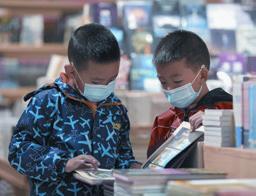STEPPING OUT IN STYLE
2020-10-22

Tourists watch a dance performance at the Yellow Crane Tower, a landmark in Wuhan, Hubei Province in central China, on October 1.
Top scenic sites in Hubei, once hard hit by the novel coronavirus disease, received over 2.07 million visitors during October 1-7, local authorities said.
This year, National Day, October 1, coincided with the Mid-Autumn Festival, as per the lunar calendar. So the annual week-long holiday was extended till October 8.

Cornucopia
A farmer harvests corn in Xituan, a village in Zhuozhou, Hebei Province in north China, on October 7.
Railway Tunnel
A tunnel on the new ChengduKunming Railway was drilled through on October 7, marking another step toward the completion of the project.
The new railway, which runs almost parallel to an existing one between the two cities, is a key project linking Sichuan and Yunnan provinces in southwest China.
The tunnel is on the EmeiMiyi section of the railway, the only section that has not been opened for operation yet, according to the China Railway No.5 Engineering Group, which participated in the construction of the tunnel.
With a designed speed of 160 km per hour, the new railway will greatly improve the passenger and cargo transport capacity in the southwestern region.
Organic Products
The number of organic product labels issued in China last year reached 2.12 billion, a marked growth from the previous year, according to the State Administration for Market Regulation, Xinhua News Agency reported on October 6.
In 2019, some 809,800 tons of labeled organic products were sold, while the total trade reached 67.82 billion yuan ($10.03 billion).
From 2015 to 2019, the number of organic product certifi cates issued in China registered an average annual growth of 13.76 percent.
The most frequently purchased organic items include vegetables, fruit, grain and dairy products.
E-commerce platforms, supermarkets and farms have become the main channels to buy organic products.
Durian Festival
A four-day online durian festival was launched in Guangxi Zhuang Autonomous Region in south China on October 5. The 2020 ChinaMalaysia (Guangxi) Online Durian Festival started in a duty-free store in the pilot free trade zone in Guangxi.
Following the ceremony, people bought 300,000 durians within 51 minutes.
Besides the main venue in Guangxi, two other venues for the festival were set up in Malaysia.
Hainan Transport
By 2025, the southern island province of Hainan will have a modern and comprehensive transport system, according to a report by Xinhua on October 4.
The network will comprise fi ve civilian airports with the Haikou Meilan International Airport, Sanya Phoenix International Airport and Qionghai Boao International Airport as its core and the other airports supplementing them, according to a plan released by the National Development and Reform Commission.
The plan targets 40 million passenger trips a year for Hainans highspeed railways and 40,000 km of highways in the province.
It will enhance Hainans role as a free trade port (FTP), an ecological civilization pilot zone and an international tourism and shopping center.
On June 1, a master plan was issued for the Hainan FTP. The province will be developed into a globally infl uential, high-level FTP by the middle of the century.
Registration Reform
China has accomplished in advance a plan to settle about 100 million people in towns and cities thanks to its fast-paced household registration reform, Xinhua reported on October 7.
The proportion of people who have a hukou, or household registration status, in towns and cities, reached 44.38 percent by 2019, up from 35.93 percent in 2013, according to the Ministry of Public Security.
A guideline on the hukou reform issued in 2014 set a goal to help around 100 million people obtain the status in towns and cities by 2020.
Policies for rural dwellers and other permanent residents to get household registration status in urban areas have been relaxed.
An open and transparent household registration system based on the points applicants earn has been implemented in megacities like Beijing, Shanghai, Guangzhou and Shenzhen.
Established in the 1950s, the hukou system classifi ed the population into rural and non-rural categories to control the movement of people between areas. Household registration, tied to ones place of residence, is needed to access basic welfare and public services.

Scenic Village
Tourists visit Niuhuang, a village in Chongqing in southwest China, on October 6. The village has improved its infrastructure, created signature landscapes, and renovated residential houses to boost tourism.
Elderly Care
China Development Bank plans to issue 100 billion yuan ($14.7 billion) of loans for elderly care services over the next fi ve years, Xinhua News Agency reported on October 8.
The loans will support 300 leading elderly care service providers and the development of senior care systems in 300 cities to cope with population aging.
By the end of August, 38.6 billion yuan ($5.7 billion) had been lent to support senior care programs in 30 provincial-level regions.
The bank said it will continue to provide fi nancial aid to such programs while strengthening risk control.
Cruise Ship
The largest roll-on/roll-off cruise ship in Asia set out for its maiden voyage from the coastal city of Yantai, Shandong Province in east China to Dalian in Liaoning Province in the northeast, on October 7, according to the local authorities.
The Zhonghuafuxing, meaning rejuvenation of the Chinese nation, is 212 meters long and 28.6 meters wide with a gross tonnage of 45,000 tons. Its 461 guest rooms can accommodate 1,689 passengers while its three-deck hold can park over 300 vehicles.
The passenger ship, independently developed and built by Chinese companies, has the largest tonnage and capacity among ships of its kind in Asia.
Animation Festival
The 16th China International Cartoon and Animation Festival in Hangzhou, capital of Zhejiang Province in east China, concluded on September 27. The six-day event attracted 10.86 million visitors online and offl ine.
The event, originally planned to be held from April 30 to May 5, was postponed due to the novel coronavirus epidemic.
Despite the impact of the epidemic, over 5,800 industry insiders and 2,600 enterprises and institutions from China and 65 foreign countries and regions participated in the event.
During the festival, more than 1,500 letters of intent for cooperation were signed and more than 100 new animation fi lms were screened. The contractual investment signed during the festival exceeded 250 million yuan ($36.8 million).

Bookworms
Children read at a bookstore in Hohhot, capital city of Inner Mongolia Autonomous Region in north China, on October 5, during the National Day holiday.
Remote Surgery
A medical team has performed a remote radical cystectomy—removing the bladder—on a patient 3,000 km away with the help of a domestically developed surgical robot using 5G technology, Xinhua reported on October 6.
Professor Niu Haitao with the Affi liated Hospital of Qingdao University in Shandong Province in east China successfully completed the operation on a patient in the Xixiu District Peoples Hospital in Anshun, a city in Guizhou Province in southwest China, through a surgical robot.
The robot accurately removed the lesions in the targeted area. At the same time, holographic projection technology enabled Niu to interact with the patient and medical staff with almost no time lag.
The patient was diagnosed with bladder cancer three months ago and was in dire need of surgery after the condition suddenly exacerbated.
The entire operation was carried out smoothly with no apparent bleeding or other complications.
Bond Connect Trade
The trading volume under Chinas Bond Connect program in September reached 419 billion yuan ($61.7 billion), according to a monthly report released by the Bond Connect Co. Ltd.
The program saw a total of 5,270 trade tickets, with an average daily turnover of 19 billion yuan ($2.8 billion) in September, the report said.
By the end of the month, the program had 2,171 approved investors, including 74 of the top 100 global asset management companies.
The Bond Connect program, launched in July 2017, is a mutual market access scheme that allows overseas investors to invest in the Chinese mainlands interbank bond market using fi nancial institutions on the mainland and in Hong Kong.
Tax Cuts
Tax and fee cuts totaled 1.88 trillion yuan ($276.06 billion) in the fi rst eight months of the year, according to the State Taxation Administration.
The preferential tax and fee measures unveiled in 2020 to support economic development and novel coronavirus disease(COVID-19) containment saved 1.17 trillion yuan ($172 billion).
The remaining 706.2 billion yuan ($103 billion) was reduced as a result of the large-scale tax and fee cuts rolled out last year.
These policies have boosted market vitality and achieved notable results, Cai Zili, an offi cial with the administration, said.
Around 92 percent of over 50 million small taxpayers were exempt from value-added tax. For the remaining 8 percent, the tax rate was lowered from 3 percent to 1 percent, Cai said. The tax was exempted in Hubei, the province badly affected by COVID-19.
In July and August, the number of new market entities handling taxrelated business increased by 15.9 percent and 21.2 percent year on year, respectively, surging from the 7.1-percent growth in the second quarter. Meanwhile, the measures reduced the labor costs of enterprises and ensured the stability of employment, Cai said.
Besides, the purchase of hi-tech equipment and services by 330,000 enterprises that enjoy preferential tax policies on research and development (R&D) rose by 24 percent in the fi rst eight months.
Since the outbreak of the epidemic, the authorities have unveiled a slew of new tax and fee relief measures.
Taxation services have also improved. Corporate taxpayers can currently conduct more than 90 percent of tax-related business online.

Growth Points
Villagers place beds for growing edible fungus in a greenhouse in Luannan, a county in Hebei Province, north China, on October 7. The countys annual edible fungus output surpassed 10,000 tons, boosting local farmers income.
Online Payments
The number of online payment service users reached 805 million by June, up 37 million from March, according to a statistical report on Chinas Internet development.
The report, released by the China Internet Network Information Center on September 29, said Junes number accounted for about 85.7 percent of Chinas total Internet population.
The number of mobile payment users expanded to 802 million, or 86 percent of mobile Internet users, according to the report.
The fi rst half of 2020 saw the total amount of online payments increasing by 18.61 percent year on year to nearly 197 trillion yuan ($29 trillion), it added, citing data from the Peoples Bank of China.
The report also found new growth potential for the online payment market. The proportion of online payment users aged 40 and above grew by 4.5 percentage points from March to June, while the proportion of rural online payment users increased by 2.7 percentage points.
Foreign Debt
There was a steady rise in outstanding foreign debt in the fi rst half of this year amid government measures to facilitate cross-border fi nancing, data from the State Administration of Foreign Exchange showed.
Outstanding foreign debt stood at $2.13 trillion by the end of June, up $75.1 billion from the end of 2019, an increase of 3.7 percent.
The increase came as a raft of measures were issued to facilitate cross-border fi nancing to support COVID-19-hit enterprises.
Among the measures, the government adjusted a key parameter in its macro-prudential management in March to allow domestic fi rms to take on more foreign debt while cutting administrative red tape to save time and costs for companies.
The increase in foreign debt is the combined result of continued opening up, policies to facilitate cross-border fi nancing as well as bullish sentiment among international investors toward the Chinese market, according to the administration.
It said the scale of foreign debt is reasonable while the structure has seen improvement, stressing that the risk of foreign debt is generally controllable.

Weaving a Better Future
Workers make rattan furniture at a resettlement site in Yuping Dong Autonomous County, Guizhou Province in southwest China, on October 7. Poverty-relief workshops provide a steady income for over 2,600 people from nine resettlement sites in the county.
Investment Catalyst
Infrastructure investment will lead Chinas recovery from the COVID-19 epidemic, as policy support continues to boost growth over the next two to three years, according to a report released by credit rating agency Moodys in September.
To boost economic growth through infrastructure investment, the government has announced stimulus policies to reduce fi nancing costs, broaden funding channels and ease fi scal constraints on regional and local governments and state-owned enterprises, Ivy Poon, Moodys Vice President and senior analyst, said.
While innovative and green infrastructure investment is a new focus, traditional infrastructure projects, such as those targeting major transportation and water conservancy, will continue to be a key driver of infrastructure spending, according to the report.
Guo Qingqing, Moodys analyst and co-author of the report, expected transportation to steer infrastructure development over the next three to fi ve years, as urbanization continues and passenger numbers and freight demand increase.
“Investments will be mainly focused on railway infrastructure in central and western regions, together with the expansion of high-speed rail, road and metro networks,” Guo said.
Tech Rebound
Beijings tech hub Zhongguancun has reported a robust economic rebound, with the total revenue of its major hi-tech enterprises surging by 9.9 percent year on year to 4 trillion yuan ($589.2 billion) in the fi rst eight months of this year.
Zhongguancun, dubbed Chinas Silicon Valley, is home to some leading Chinese information technology companies as well as startups. The electronic and information sectors total revenue rose by 17.5 percent year on year to 1.93 trillion yuan ($284 billion) from January to August, according to the Beijing Municipal Bureau of Statistics.
Other major sectors that contributed to the rebound included bioengineering and new medicine, which reported total revenue of 158.2 billion yuan ($23.2 billion), up 7 percent year on year.
The total R&D expenditure of the major hi-tech enterprises in the area surged nearly a quarter year on year to 182.8 billion yuan ($26.8 billion).

Festive Spending
Consumers shop at a duty-free store in Haikou, capital of Hainan Province in south China, on October 4.
Hainan increased its annual duty-free shopping quota from 30,000 yuan($4,419) to 100,000 yuan ($14,730) per person on July 1. Duty-free sales in the province topped 8.6 billion yuan ($1.27 billion) in the following three months, an increase of 227.5 percent year on year.
Poverty Relief
An e-commerce platform selling products from Chinas povertystricken areas has seen its sales exceed 3.1 billion yuan ($455.2 million).
Fupin832.com was co-founded by the All China Federation of Supply and Marketing Cooperatives, the Ministry of Commerce, and the State Council Leading Group Offi ce of Poverty Alleviation and Development. It sells products from 832 counties that are or were on the state list of poverty-stricken areas. Over 68,000 agricultural products are available on the website launched on January 1.
To support poverty relief through the consumption of products from poor areas, the platform has integrated online display, trading, logistics tracking and payment.
